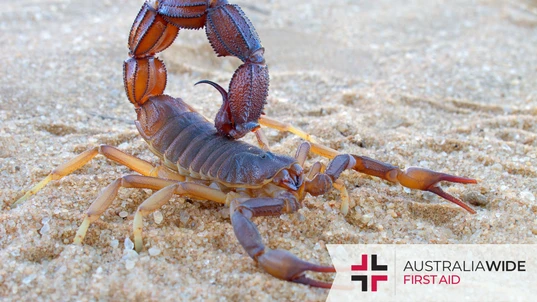Scorpions in Australia: What They Look Like and Where They Live

Bites and Stings

Though we are renowned for our wide variety of venomous snakes and spiders, Australia is also home to more than 100 species of scorpions. And while they typically live in remote habitats, they have been known to enter homes and inflict painful stings.
Here in Australia, we are renowned for our venomous snakes and spiders. But did you know we are also home to a wide variety of scorpions? Scientists estimate we could have more than 100 species of scorpions! They have even been known to enter homes, where they can inflict painful stings. If you’d like some hands-on experience dealing with bites and stings, you can attend one of our general or childcare first aid courses. We have training locations across most places in Australia.Appearance
Scorpions are unique creatures that are easily distinguished by their long, curved tails, which feature a stinger at the end. They also have two pincers that are situated at the front of their body. Australian scorpions can be anywhere between 2 to 12 cm long. Although they have multiple eyes, they don't have the best eyesight. They can still distinguish light from dark and have exceptional low light sensitivity, which helps them to navigate by moonlight or starlight and avoid harsh sunlight. To move around, scorpions rely on their sensory hairs, slit organs, and pectines, which are located on their legs (pedipalps) and body, respectively. These structures allow scorpions to pick up vibrations, scents, and ground textures. Additionally, scorpions breathe through four pairs of book lungs, which are situated on the underside of their abdomen. Female scorpions tend to be heavier and more robust than males, with shorter tails. Their coloration can range from dark grey to light brown or gold, with lighter-coloured legs. Interestingly, scorpions can fluoresce under ultraviolet light, which scientists use to observe them in the wild. This fluorescence is thought to be an ultraviolet sensitivity mechanism that helps scorpions avoid damaging light levels. A few common species you might come across in parts of Australia include:- The Desert Scorpion: A desert species, this scorpion is large, aggressive, and widespread throughout Australian deserts. To escape extreme heat during the day, it will construct deep spiral burrows that can reach a depth of up to 1m.
- Marbled Scorpion: This scorpion is small, from 1.5cm-4cm, and is mottled. It is found in southern Australia. It’s typically found in gum forests, though it has been known to enter people’s homes. It’s the main species that you will find inside your house.
Distribution and Habitat
Scorpions are common arachnids found in a variety of habitats throughout Australia. They are found under logs, rocks and in shallow burrows in earth banks. They can be found almost anywhere in Australia, but because they typically live in remote habitats and are nocturnal, they aren’t seen very often.Behaviours
Scorpions are nocturnal, and hunt during the night. Most scorpions ambush their prey that forage at or in the vicinity of their burrow, but some are more active foragers. They typically feed on anything that is smaller than them, including beetles, cockroaches, spiders, slaters, centipedes, and millipedes. Their main predators are lizards, nocturnal birds, other scorpions, marsupials, and rodents. A female scorpion will carry her young on her back for a few days or weeks, before they then leave to find food and shelter. Scorpions take a long time to reach maturity, and will moult frequently – up to six times over two to six years. They can live for up to ten years, though some species have been recorded as living up to twenty five years.Danger
Australian species of scorpions have a potent sting that can cause inflammation and pain for several hours. If you are stung by a scorpion, apply a cold pack to the affected area. Seek medical attention if the pain persists. It is important to note, no Australian scorpions are known to have fatal venom, and victims of their stings don’t typically need medical assistance. To prevent scorpion stings, wear protective clothing like gloves and shoes when working in the garden, and keep floors in the house and garage clear of clutter and debris. You can also reduce insect habitats by covering compost and garbage, and by removing building materials around the house.Final Thoughts
While you’re unlikely to come across a scorpion in Australia, it’s far from impossible. Even though Australia has no deadly species of scorpions, a sting from one can still be very painful. If you’re stung and are concerned, or the pain is lasting longer than a few hours, seek medical advice. If you’d like some hands-on experience dealing with bites and stings, you can attend one of our general or childcare first aid courses. We have locations across most places in Australia.
Originally published at
https://www.australiawidefirstaid.com.au/resources/scorpions-in-australia
as part of the Australia Wide First Aid Articles Library









